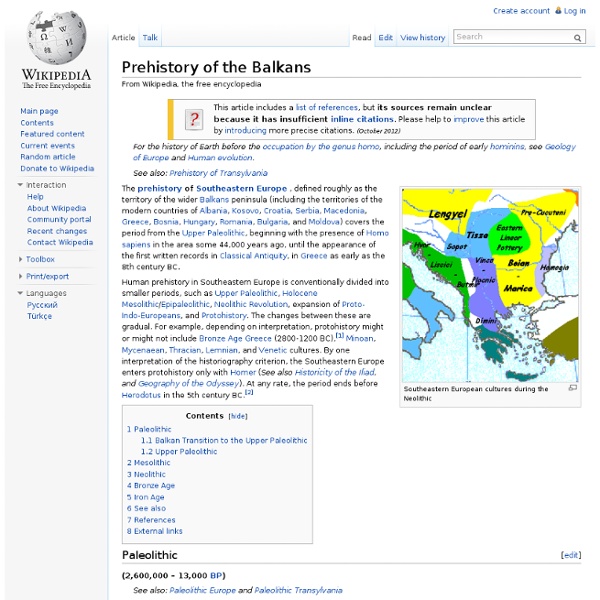Prehistory of the Balkans

Neolithic Europe
A map showing the Neolithic expansions from the 7th to the 5th millennium BC, including the Cardium Culture in blue. Europe in ca. 4500-4000 BC. Neolithic Europe refers to a prehistoric period in which Neolithic technology was present in Europe. This corresponds roughly to a time between 7000 BC (the approximate time of the first farming societies in Greece) and c. 1700 BC (the beginning of the Bronze Age in northwest Europe). The Neolithic overlaps the Mesolithic and Bronze Age periods in Europe as cultural changes moved from the southeast to northwest at about 1 km/year. The duration of the Neolithic varies from place to place, its end marked by the introduction of bronze implements: in southeast Europe it is approximately 4,000 years (i.e. 7000 BC–3000 BC) while in Northwest Europe it is just under 3,000 years (c. 4500 BC–1700 BC). Basic cultural characteristics[edit] Archaeology[edit] Europe in ca. 4000-3500 BC. Genetics[edit] Genetic studies[edit] Y-DNA based studies[edit] Language[edit]
Thracians
Thracian peltast, 5th–4th century BC. The Thracians (Ancient Greek: Θρᾷκες Thrāikes, Latin: Thraci) were a group of Indo-European tribes inhabiting a large area in Central and Southeastern Europe.[1] They were bordered by the Scythians to the north, the Celts and the Illyrians to the west, the Ancient Greeks to the south and the Black Sea to the east. They spoke the Thracian language – a scarcely attested branch of the Indo-European language family. The study of Thracians and Thracian culture is known as Thracology. Etymology[edit] The first historical record about the Thracians is found in the Iliad, where they are described as allies of the Trojans in the Trojan War against the Greeks.[2] The ethnonym Thracian comes from Ancient Greek Θρᾷξ (plural Θρᾷκες; Thrāix, Thrāikes) or Θρᾴκιος/Ionic: Θρηίκιος (Thrāikios/Thrēikios), and the toponym Thrace comes from Θρᾴκη/Ion.: Θρῄκη (Thrāikē/Thrēikē).[3] These forms are all exonyms as applied by the Greeks.[4] Mythological foundation[edit]
Thracians
The Celts
Tylis
Tylis (Greek: Τύλις) or Tyle was a capital of a short-lived Balkan state mentioned by Polybius[1] that was founded by Celts led by Comontorios in the 3rd century BC, after their invasion of Thrace and Greece in 279 BC the Gauls were defeated by Antigonus II Gonatas in the Battle of Lysimachia in 277 BC after which they turned inland to Thrace and founded their kingdom at Tylis.[2] It was located near the eastern edge of the Haemus (Balkan) Mountains in what is now eastern Bulgaria. The bands of Celts that did not settle in Thrace, crossed into Asia Minor to become known as the Galatians. The city of Tylis was eventually destroyed by the Thracians in 212 BC.[3] The modern Bulgarian village of Tulovo in Stara Zagora Province now occupies the site.[4] Tribes in Thrace and the Gauls of Tylis Tile Ridge on Greenwich Island in the South Shetland Islands, Antarctica is named for Tylis. References[edit] Coordinates:
Jupiter (Father of mythology)
The consuls swore their oath of office in Jupiter's name, and honoured him on the annual feriae of the Capitol in September. To thank him for his help (and to secure his continued support), they offered him a white ox (bos mas) with gilded horns.[10] A similar offering was made by triumphal generals, who surrendered the tokens of their victory at the feet of Jupiter's statue in the Capitol. Some scholars have viewed the triumphator as embodying (or impersonating) Jupiter in the triumphal procession.[11] During the Conflict of the Orders, Rome's plebeians demanded the right to hold political and religious office. The augures publici, augurs were a college of sacerdotes who were in charge of all inaugurations and of the performing of ceremonies known as auguria. The role of Jupiter in the conflict of the orders is a reflection of the religiosity of the Romans. The first secession was caused by the excessive burden of debts that weighed on the plebs.
Related:
Related:



